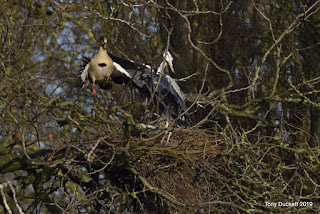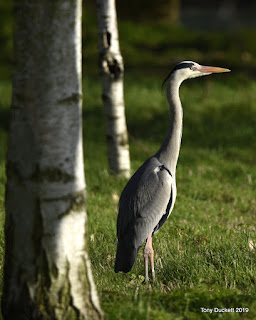Regent's Park January Highlights
January on the whole was a mild moth with periods of rain some heavy. You could count the number of days when there was a morning frost on one hand. Without a period of cold weather birds did not need to leave the continent. For that reason newcomers were few. Redwing numbers dropped to a 30 by the 20th and down to 3 on the 30th. There are still 2 female Firecrests, in grounds of Queen Mary's Gardens they aren't together but one bird has been frequenting the area by the Open Air Theatre ticket office. The Herons have been nest building, with possibly 3 pairs on the Bandstand Island and 12 males some with partners building on Heron Island. As you will see in the following photos an Egyptian Goose tried to take over a nest, probably smashing the eggs and eating them. Fortunately the male appears to have reclaimed it but the female will have to lay again. The Water Rail is still being seen in the Rail Ditch, area 2 and a probable female Cetti's Warbler is wintering in the Wetland Pen, area 32. The female Kestrel joined the male in the pen mid month. At least a pair of Blackcaps are being seen in the vicinity of the public toilets in the Rose Garden.
It would be nice to see some other winter visitors but not if it means the weather turning colder.
January pictorial
This male Great spotted Woodpecker enjoys the crushed peanuts that I put out in the holes and crevices of this fallen branch
January on the whole was a mild moth with periods of rain some heavy. You could count the number of days when there was a morning frost on one hand. Without a period of cold weather birds did not need to leave the continent. For that reason newcomers were few. Redwing numbers dropped to a 30 by the 20th and down to 3 on the 30th. There are still 2 female Firecrests, in grounds of Queen Mary's Gardens they aren't together but one bird has been frequenting the area by the Open Air Theatre ticket office. The Herons have been nest building, with possibly 3 pairs on the Bandstand Island and 12 males some with partners building on Heron Island. As you will see in the following photos an Egyptian Goose tried to take over a nest, probably smashing the eggs and eating them. Fortunately the male appears to have reclaimed it but the female will have to lay again. The Water Rail is still being seen in the Rail Ditch, area 2 and a probable female Cetti's Warbler is wintering in the Wetland Pen, area 32. The female Kestrel joined the male in the pen mid month. At least a pair of Blackcaps are being seen in the vicinity of the public toilets in the Rose Garden.
It would be nice to see some other winter visitors but not if it means the weather turning colder.
January pictorial
Grey Wagtail
This drake Teal turned up mid month and is still present
4 of the 5 European Wigeon that are wintering this year.
The Kestrels are back together and using the nest box to shelter, the male on a warm sunny morning and the female on a cold blustery one. Fingers crossed they have a good breeding season.
Peregrine Falcons are seen occasionally over the park sometimes they practice low level hunting.
Cormorants have roosted in the park since the early 90's they now leave at first light but return to bathe and are even carrying out signs of courtship.
Egyptian Goose tried to take over this Heron's nest and thankfully failed. The downside was that the eggs were destroyed by the goose.
After having one attempt as far as I was aware the Heron swung around and on the second attempt was able to scare the goose way.
The male Heron then set about reshaping and tidying up the nest, this job included eating the damaged eggs.
The relatively mild conditions means birds like this Wren and the Goldcrest below have been able to insects and other invertebrates. Long-tailed Tits have also been seen with nesting material.
This is the area of Queen Mary's Gardens that 1 female Firecrest has been favouring. One morning these Redwings were feeding on a nearby lawn.
We have had few frosty mornings these photos were taken on a very crisp sunny morning











































Comments